- For a head-mounted light, see Headlamp (outdoor).
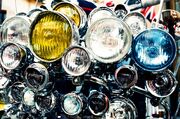
A motor scooter's front with an impractical number and variety of headlamps, added for decorative purposes
A headlamp is a lamp attached to the front of a vehicle to light the road ahead. Headlight is a synonym for headlamp.[1] Headlamp performance has steadily improved throughout the automobile age, spurred by the great disparity between daytime and nighttime traffic fatalities: the US National Highway Traffic Safety Administration states that nearly half of all traffic-related fatalities occur in the dark, despite only 25% of traffic travelling during darkness.[2]
Other vehicles, such as trains and aircraft, are required to have headlamps. Small Headlamps are often used on bicycles, and are required by law in some jurisdictions. They can be powered by a battery or a miniature generator (dymamo).
Additionally automotive night vision systems may improve viewability without requiring brighter headlamps.
History of automotive headlamps[]
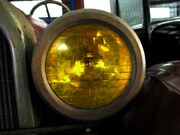
One of the first optical headlamp lenses, the Corning Conaphore. Selective yellow "Noviol" glass version shown.

1917 advertisement for the Corning Conaphore headlamp lens shown above
Mechanics[]
The earliest headlamps were fueled by acetylene or oil, and were introduced in the late 1880s. Acetylene lamps were popular because the flame was resistant to wind and rain. The first electric headlamps were introduced in 1898 on the Columbia Electric Car from the Electric Vehicle Company of Hartford, Connecticut, and were optional. Two factors limited the widespread use of electric headlamps: the short life of filaments in the harsh automotive environment, and the difficulty of producing dynamos small enough, yet powerful enough to produce sufficient current.[3]
"Prest-O-Lite" acetylene lights were offered by a number of manufacturers as standard equipment for 1904, and Peerless made electric headlamps standard in 1908. A firm in Birmingham, England called Pockley Automobile Electric Lighting Syndicate marketed the world's first electric car lights as a complete set in 1908, which consisted of headlights, sidelights and tail lights and were powered by an 8 volt battery.[4]
In 1912, Cadillac integrated their vehicle's Delco electrical ignition and lighting system, creating the modern vehicle electrical system.
"Dipping" (low beam) headlamps were introduced in 1915 by the Guide Lamp Company, but the 1917 Cadillac system allowed the light to be dipped with a lever inside the car rather than requiring the driver to stop and get out. The 1924 Bilux bulb was the first modern unit, having the light for both low (dipped) and high (main) beams of a headlamp emitting from a single bulb. A similar design was introduced in 1925 by Guide Lamp called the "Duplo". In 1927, the foot-operated dimmer switch or dip switch was introduced and became standard for much of the century. 1933-34 Packards were equipped with tri-beam headlamps, the bulbs having three filaments. From highest to lowest, the beams were called "Country Passing", "Country Driving" and "City Driving." The 1934 Nash also used a three-beam system, although in this case, the bulbs were conventional two-filament type, and the intermediate beam combined low beam on the driver's side with high beam on the passenger's side, so as to maximize the view of the roadside while minimizing glare toward oncoming traffic. The last vehicle with a foot-operated dimmer switch was the 1991 Ford F-Series.[citation needed] Fog lamps were new for 1938 Cadillacs,[citation needed] and their 1954 "Autronic Eye" system automated the selection of high and low beams.
In 1935 the Tatra T77a introduced light with cornering function - the front had three headlamps of which the central unit was linked to the steering, making it possible to turn this lamp with the steering wheel.
The standardised 7-inch (178 mm) round sealed beam headlamp was introduced in 1940, and was soon required for all vehicles sold in the United States. Britain, Australia and other Commonwealth countries, as well as Japan, also made extensive use of 7-inch sealed beams. With some exceptions from Volvo and Saab, this headlamp size format was never widely accepted in continental Europe, leading to different front-end designs for each side of the Atlantic for decades.
The first halogen lamp for vehicle headlamp use, the H1, was introduced in 1962 by a European consortium of bulb and headlamp makers. Shortly thereafter, headlamps using the new light source were introduced in Europe. Initially these were effectively prohibited in the US, where sealed beam headlamps were required. In 1978, sealed beam headlamps with internal halogen burners became available for use in the United States. Halogen sealed beams now dominate the sealed beam market, though it is considerably smaller than it was before replaceable-bulb composite headlamps returned to the US in 1983.
High-intensity discharge (HID) systems were introduced in 1991s BMW 7-series. European and Japanese markets began to prefer HID headlamps, with as much as 50% market share in those markets, but they found slow adoption in North America. 1996's Lincoln Mark VIII was an early American effort at HIDs, and was the only car with DC HIDs.
Design and style[]
Beyond the engineering, performance and regulatory-compliance aspects of headlamps, there is the consideration of the various ways they are designed and arranged on a motor vehicle. Headlamps were circular for many years, because that is the easiest shape for parabolic reflector manufacture.
Headlamp styling outside the United States, pre-1983[]
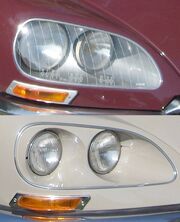
European (top) and US (bottom) headlamp configurations on a Citroën DS
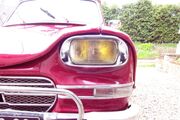
Rectangular headlamp with Selective yellow bulb on Citroën Ami 6
There was no requirement in Europe for headlamps of standardised size or shape, and lamps could be designed in any shape and size, as long as the lamps met the engineering and performance requirements contained in the applicable European safety standards. Rectangular headlamps were first used in 1961, developed by Cibié for the Citroën Ami 6 and by Hella for the German Ford Taunus. They were prohibited in the United States where round lamps were required until 1975.[citation needed] Another early headlamp styling concept involved conventional round lamps faired into the car's bodywork with aerodynamic glass covers, such as those on the 1961 Jaguar E-Type.
Headlamp styling in the United States, 1940–1983[]
In 1940, a consortium of state motor vehicle administrators standardised upon a system of two 7 in (178 mm) round sealed beam headlamps on all vehicles—the only system allowed for 17 years. A system of four round lamps, rather than two – one high/low and one high-beam 5+3/4 in (5,019 mm) sealed beam on each side – was introduced in 1957 by Cadillac, Chrysler and Nash on some of their car models in states that permitted the new system. Of these, Nash alone made the stacked lamps standard equipment on all 1957 models. Other American marques followed suit when all states permitted quad lamps in 1958.[citation needed] These lamps had some photometric advantages, particularly on high beamTemplate:According to whom and permitted more design flexibility. Auto stylists such as Virgil Exner carried out design studies with the low beams in their conventional outboard location, and the high beams vertically stacked at the centreline of the car. No such designs reached volume production; most cars had their headlights in pairs side by side on each side of the car, and some Oldsmobiles had a parking light in the middle of each pair.

5¾" sealed beam headlamps on a 1966 AMC Marlin
An example arrangement includes the stacking of two headlamps on each side with low beams above high beams. Nash used this arrangement in the 1957 model year. Pontiac used this design starting in the 1963 model year; American Motors, Ford, Cadillac and Chrysler followed two years later. Also in the 1965 model year, the Buick Riviera had concealable stacked headlamps. The Mercedes-Benz W100, W108, W111, and W112 models sold in America used this arrangement because their home-market composite lamps were illegal in the US. The British firm Alvis and the French firm Facel Vega also used this setup for some of their cars, as did Nissan in Japan.
In the late 1950s and early 1960s, Lincoln, Buick, and Chrysler arranged the headlamps diagonally by placing the low-beam lamps outboard and above the high-beam lamps. Certain British cars used a less extreme diagonal arrangement, with the inboard high-beam lamps placed only slightly lower than the outboard low-beam units. The 1965 Gordon-Keeble, Triumph Vitesse and Bentley S3 Continental used such an arrangement.[5]
In 1968 when Federal auto equipment and safety regulations were initiated, the requirement for two large or four small round sealed beams was codified, thus freezing headlamp design for many years. At the same time, the new regulations prohibited any decorative or protective element in front of the headlamps whenever the headlamps are switched on. Glass-covered headlamps, used on e.g. the Jaguar E-Type, pre-1968 VW Beetle, 1965 Chrysler and Imperial models, Porsche 356, Citroën DS and Ferrari Daytona were no longer permitted and vehicles had to be imported with uncovered headlamps for the US market. This change meant that vehicles designed for good aerodynamic performance could not achieve it for the US market.
When Federal Motor Vehicle Safety Standard 108 was amended in 1974 to permit rectangular headlamps, these were placed in horizontally arrayed or vertically stacked pairs. By 1979, the majority of new cars in the US market were equipped with rectangular lamps. Again, the US permitted only two standardised sizes of rectangular sealed-beam lamp: A system of two 200 mm × 142 mm (7.9 in × 5.6 in) high/low beam units corresponding to the existing 7-inch round format, or a system of four 165 mm × 100 mm (6.5 in × 3.9 in) units, two high/low and two high-beam. corresponding to the existing 5+3/4 in (5,019 mm) round format.
International headlamp styling, 1983–present[]
In 1983, granting a 1981 petition from Ford Motor Company, the 44-year-old US headlamp regulations were amended to allow replaceable-bulb, nonstandard-shape, architectural headlamps with aerodynamic lenses that could for the first time be plastic. This allowed the first US-market car since 1939 with replaceable bulb headlamps – the 1984 Lincoln Mark VII. These composite headlamps were sometimes referred to as "Euro" headlamps, since aerodynamic headlamps were common in Europe. Though conceptually similar to European headlamps with non-standardised shape and replaceable-bulb construction, these headlamps conform to the SAE headlamp standards of US Federal Motor Vehicle Safety Standard 108, and not the internationalised European safety standards used outside North America. Nevertheless, this change to US regulations largely united headlamp styling within and outside the North American market.
In the late 1990s, round headlamps returned to popularity on new cars. These are generally not the discrete self-contained round lamps as found on older cars (certain Jaguars excepted), but rather involve circular or oval optical elements within an architecturally-shaped housing assembly.
Hidden headlamps[]
| This section may contain original research. Please improve it by verifying the claims made and adding references. Statements consisting of original research are allowed on Tractor Wiki, but the validity of entries on this page are being challenged !! More details of any issues with this article may be available on the talk page. Note:- wikipedia does not allow OR so this template may be present in articles copied from wikipedia and should be removed if nolonger required following review of the content. (November 2012) |
- Main article: Hidden headlamps
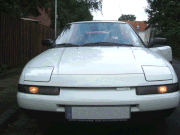
Pop up headlamps on a Mazda 323F
Hidden headlamps were introduced in 1936,[citation needed] on the Cord 810. They were mounted in the front fenders, which were smooth until the lights were cranked out - each with its own small dash-mounted crank - by the operator. They aided aerodynamics when the headlamps were not in use, and were among the Cord's signature design features.
Many notableTemplate:According to whom cars used this feature, but no modern volume-produced car models use hidden headlamps, because they present difficulties in complying with pedestrian-protection provisions added to international auto safety regulations in the 2000s, and because the mechanisms are costly and heavy.[citation needed] Hidden headlamps require one or more vacuum-operated servos and reservoirs, with associated plumbing and linkage, or electric motors, geartrains and linkages to raise the lamps to an exact position to assure correct aiming despite ice, snow and age. Some early[when?] hidden headlamps, such as those on the Saab Sonett III, used a lever-operated mechanical linkage to raise the headlamps into position. Current market demands place a premium on vehicles' aerodynamic performance with lamps off and on, further reducing the attractiveness of pop-up headlamps. In addition, recent ECE regulations contain standards regarding protuberances on car bodies to minimise injury to pedestrians struck by cars.
Some hidden headlamps themselves do not move, but rather are covered when not in use by panels designed to blend in with the car's styling. When the lamps are switched on, the covers are swung out of the way, usually downward or upward, for example on the 1992 Jaguar XJ220. The door mechanism may be actuated by vacuum pots, as on some Ford vehicles of the late 1960s through early 1980s such as the 1967-1970 Mercury Cougar, or by an electric motor as on various Chrysler products of the middle 1960s through late 1970s such as the 1966-1967 Dodge Charger.
Regulations and requirements[]
Modern headlamps are electrically operated, positioned in pairs, one or two on each side of the front of a vehicle. A headlamp system is required to produce a low and a high beam, which may be achieved either by an individual lamp for each function or by a single multifunction lamp. High beams (called "main beams" or "full beams" or "driving beams" in some countries) cast most of their light straight ahead, maximizing seeing distance, but producing too much glare for safe use when other vehicles are present on the road. Because there is no special control of upward light, high beams also cause backdazzle from fog, rain and snow due to the retroreflection of the water droplets. Low beams (called "dipped beams" or "passing beams" in some countries) have stricter control of upward light, and direct most of their light downward and either rightward (in right-traffic countries) or leftward (in left-traffic countries), to provide safe forward visibility without excessive glare or backdazzle.
 ECE dipped/low beam |
 Asymmetrical low beam illumination of road surface – right-traffic beam shown |
Low beam[]
Low beam (dipped beam, passing beam, meeting beam) headlamps provide a distribution of light designed to provide adequate forward and lateral illumination with limits on light directed towards the eyes of other road users, to control glare. This beam is intended for use whenever other vehicles are present ahead.
The international ECE Regulations for filament headlamps[6] and for high-intensity discharge headlamps[7] specify a beam with a sharp, asymmetric cutoff preventing significant amounts of light from being cast into the eyes of drivers of preceding or oncoming cars. Control of glare is less strict in the North American SAE beam standard contained in FMVSS / CMVSS 108.[8]
High beam[]
 ECE high/main beam |
 Symmetrical high beam illumination of road surface |
High beam (main beam, driving beam, full beam) headlamps provide a bright, centre-weighted distribution of light with no particular control of light directed towards other road users' eyes. As such, they are only suitable for use when alone on the road, as the glare they produce will dazzle other drivers.
International ECE Regulations permit higher-intensity high-beam headlamps than are allowed under North American regulations.[9]
Compatibility with traffic directionality[]
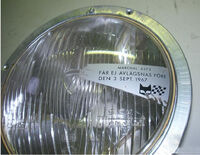
Headlamp sold in Sweden not long before Dagen H changeover from left to right hand traffic.
Opaque decal blocks the lens portion for low beam upkick to the right, and bears warning:
"Not to be removed before 3 September 1967".
Most low-beam headlamps are specifically designed for use on only one side of the road. Headlamps for use in left-traffic countries have low-beam headlamps that "dip to the left"; the light is distributed with a downward/leftward bias to show the driver the road and signs ahead without blinding oncoming traffic. Headlamps for right-traffic countries have low beams that "dip to the right", with most of their light directed downward/rightward. Within Europe, when driving a vehicle with right-traffic headlamps in a left-traffic country or vice versa for a limited time (as for example on vacation or in transit), it is a legal requirement to adjust the headlamps temporarily so that their wrong-side beam distribution does not dazzle oncoming drivers. This may be achieved by methods including adhering opaque decals or prismatic lenses to a designated part of the lens. Some projector-type headlamps can be made to produce a proper left- or right-traffic beam by shifting a lever or other movable element in or on the lamp assembly.[10] Many tungsten (pre-halogen) European-code headlamps made in France by Cibié, Marchal, and Ducellier could be adjusted to produce either a left- or a right-traffic low beam by means of a two-position bulb holder.
Because wrong-side-of-road headlamps blind oncoming drivers and do not adequately light the driver's way, and blackout strips and adhesive prismatic lenses reduce the safety performance of the headlamps, some countries require all vehicles registered or used on a permanent or semipermanent basis within the country to be equipped with headlamps designed for the correct traffic-handedness.Template:According to whom North American vehicle owners sometimes privately import and install Japanese-market (JDM) headlamps on their car.
Use in daytime[]
- Main article: Daytime running lamp
Some countries require automobiles to be equipped with daytime running lights (DRL) to increase the conspicuity of vehicles in motion during the daytime. Regional regulations govern how the DRL function may be provided. In Canada the DRL function required on vehicles made or imported since 1990 can be provided by the headlamps, the fog lamps, steady-lit operation of the front turn signals, or by special daytime running lamps.[11] Functionally dedicated daytime running lamps not involving the headlamps are required on all new cars first sold in the European Union since February 2011.[12] In addition to the EU and Canada, countries requiring DRL include Albania, Argentina,[13] Bosnia and Herzegovina, Colombia, Croatia, Iceland, Israel, Macedonia, Norway, Moldova, Russia, Serbia, and Uruguay.[citation needed]
Construction, performance, and aim[]
There are two different beam pattern and headlamp construction standards in use in the world: The ECE standard, which is allowed or required in virtually all industrialized countries except the United States, and the SAE standard that is mandatory only in the US. Japan formerly had bespoke lighting regulations similar to the US standards, but for the left side of the road. However, Japan now adheres to the ECE standard. The differences between the SAE and ECE headlamp standards are primarily in the amount of glare permitted toward other drivers on low beam (SAE permits much more glare), the minimum amount of light required to be thrown straight down the road (SAE requires more), and the specific locations within the beam at which minimum and maximum light levels are specified.
ECE low beams are characterized by a distinct horizontal "cutoff" line at the top of the beam. Below the line is bright, and above is dark. On the side of the beam facing away from oncoming traffic (right in right-traffic countries, left in left-traffic countries), this cutoff sweeps or steps upward to direct light to road signs and pedestrians. SAE low beams may or may not have a cutoff, and if a cutoff is present, it may be of two different general types: VOL, which is conceptually similar to the ECE beam in that the cutoff is located at the top of the left side of the beam and aimed slightly below horizontal, or VOR, which has the cutoff at the top of the right side of the beam and aimed at the horizon.[14]
Proponents of each headlamp system decry the other as inadequate and unsafe: US proponents of the SAE system claim that the ECE low beam cutoff gives short seeing distances and inadequate illumination for overhead road signs, while international proponents of the ECE system claim that the SAE system produces too much glare.[15] Comparative studies have repeatedly shown that there is little or no overall safety advantage to either SAE or ECE beams; the two systems' acceptance and rejection by various countries is based primarily on which system is already in use.[14][16]
In North America, the design, performance and installation of all motor vehicle lighting devices are regulated by Federal and Canada Motor Vehicle Safety Standard 108, which incorporates SAE technical standards. Elsewhere in the world, ECE internationalised regulations are in force either by reference or by incorporation in individual countries' vehicular codes.
US laws required sealed beam headlamps on all vehicles between 1940 and 1983, and other countries such as Japan, United Kingdom and Australia also made extensive use of sealed beams.[when?] In most other countries, and in the US since 1984, replaceable-bulb headlamps predominate.
Headlamps must be kept in proper alignment (or "aim").[17] Regulations for aim vary from country to country and from beam specification to beam specification. In the US, SAE standard headlamps are aimed without regard to headlamp mounting height. This gives vehicles with high-mounted headlamps a seeing distance advantage, at the cost of increased glare to drivers in lower vehicles. By contrast, ECE headlamp aim angle is linked to headlamp mounting height, to give all vehicles roughly equal seeing distance and all drivers roughly equal glare.[18]
Light color[]
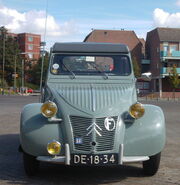
1957 Citroën 2CV with selective yellow headlamps and auxiliary lamp
Headlamps are generally required to produce white light, according to both ECE and SAE standards. ECE Regulation 48 currently requires new vehicles to be equipped with headlamps emitting white light.[19] Previous ECE regulations also permitted selective yellow light, which from 1936 until 1993 was required on all vehicles registered in France. Selective yellow headlamps are no longer required anywhere, but are permitted throughout Europe on vehicles already so equipped, as well as in non-European locales such as South Korea, Japan[20] and New Zealand.[21] Though in Iceland yellow headlamps are allowed on new cars to this day.[22]
Optical systems[]
Reflector lamps[]
Lens optics[]
 Lens optics, side view. Light is dispersed vertically (shown) and laterally (not shown). |
 A 7 in. round sealed-beam headlamp with lens optics on a Jaguar E-type. The flutes and prisms spread and distribute the light collected by the reflector. |
A light source (filament or arc) is placed at or near the focus of a reflector, which may be parabolic or of non-parabolic complex shape. Fresnel and prism optics moulded into the headlamp lens refract (shift) parts of the light laterally and vertically to provide the required light distribution pattern. Most sealed-beam headlamps have lens optics.[23]
Reflector optics[]
 Reflector optics, side view |
 A reflector-optic headlamp on a Jeep Liberty. The clear front cover lens serves only a protective function. |
Starting in the 1980s, headlamp reflectors began to evolve beyond the simple stamped steel parabola. The 1983 Austin Maestro was the first vehicle equipped with Lucas-Carello's homofocal reflectors, which comprised parabolic sections of different focal length to improve the efficiency of light collection and distribution.[24] CAD technology allowed the development of reflector headlamps with nonparabolic, complex-shape reflectors. First commercialised by Valeo under their Cibié brand, these headlamps would revolutionise automobile design.[25]
The 1987 US-market Dodge Monaco/Eagle Premier twins and European Citroën XM were the first cars with complex-reflector headlamps[26] with faceted optic lenses. General Motors' Guide Lamp division in America had experimented with clear-lens complex-reflector lamps in the early 1970s and achieved promising results,[27] but the US-market 1990 Honda Accord was first with clear-lens multi-reflector headlamps; these were developed by Stanley in Japan.[28] The optics to distribute the light in the desired pattern are designed into the reflector itself, rather than into the lens. Depending on the development tools and techniques in use, the reflector may be engineered from the start as a bespoke shape, or it may start as a parabola standing in for the size and shape of the completed package. In the latter case, the entire surface area is modified so as to produce individual segments of specifically calculated, complex contours. The shape of each segment is designed such that their cumulative effect produces the required light distribution pattern.[23]
Modern reflectors are commonly made of compression-moulded or injection moulded plastic, though glass and metal optic reflectors also exist. The reflective surface is vapour deposited aluminium with a clear overcoating to prevent the extremely thin aluminium from oxidizing. Extremely tight tolerances must be maintained in the design and production of complex-reflector headlamps.
Dual-beam reflector headlamps[]
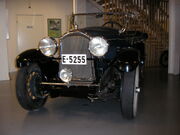
1928 Willys-Knight 70A Touring. Notice the directional headlight in the middle.
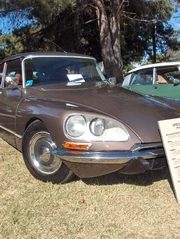
Directional (steering) headlamps on a Citroën DS – the driver can see his way through curves.
Night driving is difficult and dangerous due to the blinding glare of headlights from oncoming traffic. Headlamps that satisfactorily illuminate the road ahead without causing glare have long been sought. The first solutions involved resistance-type dimming circuits, which decreased the intensity of the headlamps. This yielded to tilting reflectors, and later to dual-filament bulbs with a high and a low beam.
In a two-filament headlamp, there can only be one filament exactly at the focal point of the reflector. There are two primary means of producing two different beams from a two-filament bulb in a single reflector.
American system[]
One filament is located at the focal point of the reflector. The other filament is shifted axially and radially away from the focal point. In most 2-filament sealed beams and in 2-filament replaceable bulbs of type 9004, 9007, and H13, the high-beam filament is at the focal point and the low-beam filament is off focus. For use in right-traffic countries, the low-beam filament is positioned slightly upward, forward and leftward of the focal point, so that when it is energised, the beam is widened and shifted slightly downward and rightward of the headlamp axis. Transverse-filament bulbs such as the 9004 can only be used with the filaments horizontal, but axial-filament bulbs can be rotated or "clocked" by the headlamp designer to optimise the beam pattern or to effect the traffic-handedness of the low beam. The latter is accomplished by clocking the low-beam filament in an upward-forward-leftward position to produce a right-traffic low beam, or in an upward-forward-rightward position to produce a left-traffic low beam.
The opposite tactic has also been employed in certain 2-filament sealed beams. Placing the low beam filament at the focal point to maximise light collection by the reflector, and positioning the high beam filament slightly rearward-rightward-downward of the focal point. The relative directional shift between the two beams is the same with either technique – in a right-traffic country, the low beam is slightly downward-rightward and the high beam is slightly upward-leftward, relative to one another – but the lens optics must be matched to the filament placements selected.
European system[]
The traditional European method of achieving low and high beam from a single bulb involves two filaments along the axis of the reflector. The high beam filament is on the focal point, while the low beam filament is approximately 1 cm forward of the focal point and 3 mm above the axis. Below the low beam filament is a cup-shaped shield (called a "Graves Shield") spanning an arc of 165°. When the low beam filament is illuminated, this shield casts a shadow on the corresponding lower area of the reflector, blocking downward light rays that would otherwise strike the reflector and be cast above the horizon. The bulb is rotated (or "clocked") within the headlamp to position the Graves Shield so as to allow light to strike a 15° wedge of the lower half of the reflector. This is used to create the upsweep or upstep characteristic of ECE low beam light distributions. The bulb's rotative position within the reflector depends on the type of beam pattern to be produced and the traffic directionality of the market for which the headlamp is intended.
This system was first used with the tungsten incandescent Bilux/Duplo R2 bulb of 1954, and later with the halogen H4 bulb of 1971. In 1992, US regulations were amended to permit the use of H4 bulbs redesignated HB2 and 9003, and with slightly different production tolerances stipulated. These are physically and electrically interchangeable with H4 bulbs.[29] Similar optical techniques are used, but with different reflector or lens optics to create a US beam pattern rather than a European one.
Each system has its advantages and disadvantages. The American system historically permitted a greater overall amount of light within the low beam, since the entire reflector and lens area is used, but at the same time, the American system has traditionally offered much less control over upward light that causes glare, and for that reason has been largely rejected outside the US. In addition, the American system makes it difficult to create markedly different low and high beam light distributions. The high beam is usually a rough copy of the low beam, shifted slightly upward and leftward. The European system traditionally produced low beams containing less overall light, because only 60% of the reflector's surface area is used to create the low beam. However, low beam focus and glare control are easier to achieve. In addition, the lower 40% of the reflector and lens are reserved for high beam formation, which facilitates the optimisation of both low and high beams.
Developments in the 1990s and 2000s[]
Complex-reflector technology in combination with new bulb designs such as H13 is enabling the creation of European-type low and high beam patterns without the use of a Graves Shield, while the 1992 US approval of the H4 bulb has made traditionally European 60% / 40% optical area divisions for low and high beam common in the US. Therefore, the difference in active optical area and overall beam light content no longer necessarily exists between US and ECE beams. Dual-beam HID headlamps employing reflector technology have been made using adaptations of both techniques.
Projector (polyellipsoidal) lamps[]
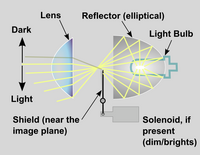 Projector optics, side view |
 Projector headlamps on an Acura RL |
In this system a filament is located at one focus of an ellipsoidal reflector and has a condenser lens at the front of the lamp. A shade is located at the image plane, between the reflector and lens, and the projection of the top edge of this shade provides the low-beam cutoff. The shape of the shade edge, and its exact position in the optical system, determines the shape and sharpness of the cutoff.[23] The shade may be lowered by a solenoid actuated pivot to provide low beam, and removed from the light path for high beam. Such optics are known as BiXenon or BiHalogen projectors. If the cutoff shade is fixed in the light path, separate high-beam lamps are required. The condenser lens may have slight fresnel rings or other surface treatments to reduce cutoff sharpness. Modern condenser lenses incorporate optical features specifically designed to direct some light upward towards the locations of retroreflective overhead road signs.
Hella introduced ellipsoidal optics for acetylene headlamps in 1911, but following the electrification of vehicle lighting, this optical technique wasn't used for many decades. The first modern polyellipsoidal (projector) automotive lamp was the Super-Lite, an auxiliary headlamp produced in a joint venture between Chrysler Corporation and Sylvania and optionally installed in 1969 and 1970 full-size Dodge automobiles. It used an 85 watt transverse-filament tungsten-halogen bulb and was intended as a mid-beam, to extend the reach of the low beams during turnpike travel when low beams alone were inadequate but high beams would produce excessive glare.[30]
Projector main headlamps first appeared in 1981 on the Audi Quartz, the Quattro-based concept car designed by Pininfarina for Geneva Auto Salon.[citation needed] Developed more or less simultaneously in Germany by Hella and Bosch and in France by Cibié, the projector low beam permitted accurate beam focus and a much smaller-diameter optical package, though a much deeper one, for any given beam output. The version of the 1986 BMW 7 Series sold outside North America was the first volume-production auto to use polyellipsoidal low beam headlamps. The main disadvantage of this type of headlamp is the need to accommodate the physical depth of the assembly, which may extend far back into the engine compartment.
Light sources[]
- Main article: Automotive light sources

The headlight unit found on the 2014 Ford Fusion. The low beams utilize a projector beam configuration. (North America)
Tungsten[]
The first electric headlamp light source was the tungsten filament, operating in a vacuum or inert-gas atmosphere inside the headlamp bulb or sealed beam. Compared to newer-technology light sources, tungsten filaments give off small amounts of light relative to the power they consume. Also, during normal operation of such lamps, tungsten boils off the surface of the filament and condenses on the bulb glass, blackening it. This reduces the light output of the filament and blocks some of the light that would pass through an unblackened bulb glass, though blackening was less of a problem in sealed beam units; their large interior surface area minimised the thickness of the tungsten accumulation. For these reasons, plain tungsten filaments are all but obsolete in automotive headlamp service.
Tungsten-halogen[]
Tungsten-halogen technology (also called "quartz-halogen", "quartz-iodine", "iodine cycle", etc.) increases the effective luminous efficacy of a tungsten filament: when operating at a higher filament temperature which results in more lumens output per watt input, a tungsten-halogen lamp has a much longer brightness lifetime than similar filaments operating without the halogen regeneration cycle. At equal luminosity, the halogen-cycle bulbs also have longer lifetimes. European-designed halogen headlamp light sources are generally configured to provide more light at the same power consumption as their lower-output plain tungsten counterparts. By contrast, many US-based designs are configured to reduce or minimise the power consumption while keeping light output above the legal minimum requirements; some US tungsten-halogen headlamp light sources produce less initial light than their non-halogen counterparts.[16] A slight theoretical fuel economy benefit and reduced vehicle construction cost through lower wire and switch ratings were the claimed benefits when American industry first chose how to implement tungsten-halogen technology. There was an improvement in seeing distance with US halogen high beams, which were permitted for the first time to produce 150,000 candela (cd) per vehicle, double the nonhalogen limit of 75,000 cd but still well shy of the international European limit of 225,000 cd. After replaceable halogen bulbs were permitted in US headlamps in 1983, development of US bulbs continued to favour long bulb life and low power consumption, while European designs continued to prioritise optical precision and maximum output.[16]
The H1 lamp was the first tungsten-halogen headlamp light source. It was introduced in 1962 by a consortium of European bulb and headlamp makers. This bulb has a single axial filament that consumes 55 watts at 12.0 volts, and produces 1550 lumens ±15% when operated at 13.2 V. H2 (55 W @ 12.0 V, 1820 lm @ 13.2 V) followed in 1964, and the transverse-filament H3 (55 W @ 12.0 V, 1450 lm ±15%) in 1966. H1 still sees wide use in low beams, high beams and auxiliary fog and driving lamps, as does H3. The H2 is no longer a current type, since it requires an intricate bulb holder interface to the lamp, has a short life and is difficult to handle. For those reasons, H2 was withdrawn[31] from ECE Regulation 37 for use in new lamp designs (though H2 bulbs are still manufactured for replacement purposes in existing lamps), but H1 and H3 remain current and these two bulbs were legalised in the United States in 1993.[32][33] More recent single-filament bulb designs include the H7 (55 W @ 12.0 V, 1500 lm ±10% @ 13.2 V), H8 (35 W @ 12.0 V, 800 lm ±15% @ 13.2 V), H9 (65 W @ 12.0 V, 2100 lm ±10% @ 13.2 V), and H11 (55 W @ 12.0 V, 1350 lm ±10% @ 13.2 V). 24-volt versions of many bulb types are available for use in trucks, buses, and other commercial and military vehicles.
The first dual-filament halogen bulb (to produce a low and a high beam with only one bulb), the H4, was released in 1971 and quickly became the predominant headlamp bulb throughout the world except in the United States, where the H4 is still not legal for automotive use. In 1992, the Americans created their own standard for a bulb called HB2/9003, almost identical to H4 except with more stringent constraints on filament geometry and positional variance, and power consumption and light output expressed at the US test voltage of 12.8V.
The first US halogen headlamp bulb, introduced in 1983, was the HB1/9004. It is a 12.8-volt, transverse dual-filament design that produces 700 lumens on low beam and 1200 lumens on high beam. The 9004 is rated for 65 watts (high beam) and 45 watts (low beam) at 12.8 volts. Other US approved halogen bulbs include the 9005/HB3 (65 W, 12.8 V), 9006/HB4 (55 W, 12.8 V), and 9007/HB5 (65/55 watts, 12.8 V). All of the European-designed and internationally approved bulbs except H4 are presently approved for use in headlamps complying with US requirements.
Halogen infrared reflective (HIR)[]
A further development of the tungsten-halogen bulb has a dichroic coating that passes visible light and reflects infrared radiation. The glass in such a bulb may be spherical or tubular. The reflected infrared radiation strikes the filament located at the center of the glass envelope, heating the filament to a greater degree than can be achieved through resistive heating alone. The superheated filament emits more light without an increase in power consumption.
High-intensity discharge (HID)[]
| This section does not cite any references or sources. Please help improve this article by adding citations to reliable sources. Unverifiable material may be challenged and removed. (November 2012) |
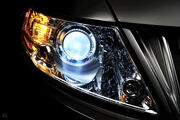
HID projector low beam headlamp illuminated on a Lincoln MKS
High-intensity discharge lamps (HID) produce light with an electric arc rather than a glowing filament. The high intensity of the arc comes from metallic salts that are vapourised within the arc chamber. These lamps are formally known as gas-discharge burners,[by whom?] and have a higher efficacy than tungsten lamps. Because of the increased amounts of light available from HID burners relative to halogen bulbs, HID headlamps producing a given beam pattern can be made smaller than halogen headlamps producing a comparable beam pattern. Alternatively, the larger size can be retained, in which case the xenon headlamp can produce a more robust beam pattern.[original research?]
Automotive HID may be called "xenon headlamps", though they are actually metal-halide lamps that contain xenon gas. The xenon gas allows the lamps to produce minimally adequate light immediately upon start, and shortens the run-up time. The usage of argon, as is commonly done in street lights and other stationary metal-halide lamp applications, causes lamps to take several minutes to reach their full output.
The light from HID headlamps can exhibit a distinct bluish tint when compared with tungsten-filament headlamps, although a range of spectra are available commonly specified as a Colour Temperature.
Retrofitment[]
When a halogen headlamp is retrofitted with an HID bulb, light distribution and output are altered.[34] In the United States, vehicle lighting that do not conform to FMVSS 108 are not street legal.[34] Glare will be produced and the headlamp's type approval or certification becomes invalid with the altered light distribution, so the headlamp is no longer street-legal in some locales.[35] In the US, suppliers, importers and vendors that offer non-compliant kits are subject to civil fines. By October 2004, the NHTSA had investigated 24 suppliers and all resulted in termination of sale or recalls.[36]
In Europe and the many non-European countries applying ECE Regulations, even HID headlamps designed as such must be equipped with lens cleaning and automatic self-leveling systems, except on motorcycles.[35] These systems are usually absent on vehicles not originally equipped with HID lamps.
History[]
Xenon headlamps were introduced as an option on the BMW 7-series in 1991 for Europe, and in 1993 for US models. This first system used an unshielded, non-replaceable burner designated D1 – a designation that would be recycled years later for a wholly different type of burner. The AC ballast was about the size of a building brick. The first American-made effort at HID headlamps was on the 1996-98 Lincoln Mark VIII, which used reflector headlamps with an unmasked, integral-ignitor burner made by Sylvania and designated Type 9500. This was the only system to operate on DC, since reliability proved inferior to the AC systems.[citation needed] The Type 9500 system was not used on any other models, and was discontinued after Osram's takeover of Sylvania in 1997.[citation needed] All HID headlamps worldwide presently use the standardised AC-operated bulbs and ballasts.
Operation[]
HID headlamp bulbs do not run on low-voltage DC current, so they require a ballast with either an internal or external ignitor. The ignitor is integrated into the bulb in D1 and D3 systems, and is either a separate unit or part of the ballast in D2 and D4 systems. The ballast controls the current to the bulb. The ignition and ballast operation proceeds in three stages:
- Ignition: a high voltage pulse is used to produce a spark – in a manner similar to a spark plug – which ionises the Xenon gas, creating a conducting tunnel between the tungsten electrodes. Electrical resistance is reduced within the tunnel, and current flows between the electrodes.
- Initial phase: the bulb is driven with controlled overload. Because the arc is operated at high power, the temperature in the capsule rises quickly. The metallic salts vapourise, and the arc is intensified and made spectrally more complete. The resistance between the electrodes also falls; the electronic ballast control gear registers this and automatically switches to continuous operation.
- Continuous operation: all metal salts are in the vapour phase, the arc has attained its stable shape, and the luminous efficacy has attained its nominal value. The ballast now supplies stable electrical power so the arc will not flicker. Stable operating voltage is 85 volts AC in D1 and D2 systems, 42 volts AC in D3 and D4 systems. The frequency of the square-wave alternating current is typically 400 hertz or higher.
Burner types[]
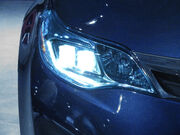
The headlight assembly found on the 2014 Toyota Avalon. The Avalon features HID Quadrabeam headlights and LED Daytime Running Lights (DRL), that also illuminate with the low beams turned on. (North America)
HID headlamp burners produce between 2,800 and 3,500 lumens from between 35 and 38 watts of electrical power, while halogen filament headlamp bulbs produce between 700 and 2,100 lumens from between 40 and 72 watts at 12.8 V.[37][38][39]
Current-production burner categories are D1S, D1R, D2S, D2R, D3S, D3R, D4S, and D4R. The D stands for discharge, and the number is the type designator. The final letter describes the outer shield. The arc within an HID headlamp bulb generates considerable short-wave ultraviolet (UV) light, but none of it escapes the bulb, for a UV-absorbing hard glass shield is incorporated around the bulb's arc tube. This is important to prevent degradation of UV-sensitive components and materials in headlamps, such as polycarbonate lenses and reflector hardcoats. "S" burners – D1S, D2S, D3S, and D4S – have a plain glass shield and are primarily used in projector-type optics. "R" burners – D1R, D2R, D3R, and D4R – are designed for use in reflector-type headlamp optics. They have an opaque mask covering specific portions of the shield, which facilitates the optical creation of the light/dark boundary (cutoff) near the top of a low-beam light distribution. Automotive HID burners do emit considerable near-UV light, despite the shield.
Color[]
The correlated colour temperature of factory installed automotive HID headlamps is between 4100K and 5000K[citation needed] while tungsten-halogen lamps are at 3000K to 3550K. The spectral power distribution (SPD) of an automotive HID headlamp is discontinuous and spikey while the SPD of a filament lamp, like that of the sun, is a continuous curve. Moreover, the color-rendering index (CRI) of tungsten-halogen headlamps (98) is much closer than that of HID headlamps (~75) to standardised sunlight (100). Studies have shown no significant safety effect of this degree of CRI variation in headlighting.[40][41][42][43]
Advantages[]
Increased safety[]
Automotive HID lamps offer about 3000 lumens and 90 Mcd/m2 versus 1400 lumens and 30 Mcd/m2Template:Disputed inline offered by halogen lamps. In a headlamp optic designed for use with an HID lamp, it produces more usable light. Studies have demonstrated drivers react faster and more accurately to roadway obstacles with good HID headlamps than halogen ones.[44] Hence, good HID headlamps contribute to driving safety.[45] The contrary argument is that glare from HID headlamps can reduce traffic safety by interfering with other drivers' vision.
Efficacy and output[]
Luminous efficacy is the measure of how much light is produced versus how much energy is consumed. HID burners give higher efficacy than halogen lamps. The highest-intensity halogen lamps, H9 and HIR1, produce 2100 to 2530 lumens from approximately 70 watts at 13.2 volts. A D2S HID burner produces 3200 lumens from approximately 42 watts during stable operation.[37] The reduced power consumption means less fuel consumption, with resultant less CO2 emission per vehicle fitted with HID lighting (1.3 g/km assuming that 30% of engine running time is with the lights on).
Longevity[]
The average service life of an HID lamp is 2000 hours, compared to between 450 and 1000 hours for a halogen lamp.[46]
Disadvantages[]
Glare[]
Vehicles equipped with HID headlamps (except motorcycles) are required by ECE regulation 48 also to be equipped with headlamp lens cleaning systems and automatic beam leveling control. Both of these measures are intended to reduce the tendency for high-output headlamps to cause high levels of glare to other road users. In North America, ECE R48 does not apply and while lens cleaners and beam levelers are permitted, they are not required;[47] HID headlamps are markedly less prevalent in the US, where they have produced significant glare complaints.[48] Scientific study of headlamp glare has shown that for any given intensity level, the light from HID headlamps is 40% more glaring than the light from tungsten-halogen headlamps.[49]
Mercury content[]
HID headlamp bulb types D1R, D1S, D2R, D2S and 9500 contain the toxic heavy metal mercury. The disposal of mercury-containing vehicle parts is increasingly regulated throughout the world, for example under US EPA regulations. Newer HID bulb designs D3R, D3S, D4R, and D4S which are in production since 2004 contain no mercury,[50][51] but are not electrically or physically compatible with headlamps designed for previous bulb types.
Cost[]
HID headlamps are significantly more costly to produce, install, purchase, and repair. The extra cost of the HID lights may exceed the fuel cost savings through their reduced power consumption, though some of this cost disadvantage is offset by the longer lifespan of the HID burner relative to halogen bulbs.
LED[]

First production LED headlamps on the Lexus LS 600h
Automotive headlamp applications using light-emitting diodes (LEDs) have been undergoing very active development since 2004.[52][53] The first series-production LED headlamps were factory-installed on the Lexus LS 600h / LS 600h L presented in 2007 for 2008 models. Low beam, front position light and sidemarker functions are performed by LEDs; high beam and turn signal functions use filament bulbs. The headlamp is supplied by Koito. Full-LED headlamps supplied by AL-Automotive Lighting were fitted on the 2008 V10 Audi R8 sports car except in North America. The Hella headlamps on the 2009 Cadillac Escalade Platinum became the first US market all-LED headlamps.
Designs as of MY2010, such as those available as optional equipment on the 2010 Toyota Prius, give performance between halogen and HID headlamps,[54] with system power consumption slightly lower than other headlamps, longer lifespans and more flexible design possibilities.[55][56] As LED technology continues to evolve, the performance of LED headlamps is predicted to improve to approach, meet, and perhaps one day surpass that of HID headlamps.[57]
The limiting factors with LED headlamps presently include high system expense, regulatory delays and uncertainty, and logistical issues created by LED operating characteristics. As a semiconductor, the performance of an LED is dependent on its temperature; a given diode will produce more light at a low temperature than at a high temperature. Thus, in order to maintain a constant light output, the temperature of an LED headlamp must be kept relatively stable. LEDs are commonly considered to be low-heat devices due to the public's familiarity with small, low-output LEDs used for electronic control panels and other applications requiring only small amounts of light; however, LEDs actually produce a significant amount of heat per unit of light output. Rather than being emitted together with the light as is the case with conventional light sources, an LED's heat is produced at the rear of the emitters. Unlike incandescent and HID bulbs, LEDs are damaged by high temperatures; prolonged operation above the maximum junction temperature will permanently degrade the LEDs and ultimately shorten the device's life. The need to keep LED junction temperatures low at high power levels requires thermal management measures such as heatsinks or cooling fans which are typically quite expensive.[58]
Additional facets of the thermal issues with LED headlamps reveal themselves in cold ambient temperatures. Not only can excessively low temperatures lead to the LED's light output increasing beyond the regulated maximum, but heat must in addition be effectively applied to thaw snow and ice from the front lenses, which are not heated by the comparatively small amount of infrared radiation emitted forward with the light from LEDs.[59]
LEDs are increasingly being adopted for signal functions such as parking lamps, brake lamps and turn signals as well as daytime running lamps, as in those applications they offer significant advantages over filament bulbs with fewer engineering challenges than headlamps pose.
Automatic headlamps[]
Automatic systems for activating the headlamps have been available since the mid-1960s,[citation needed] originally only on luxury American models such as Lincoln, Cadillac, and Imperial.[citation needed] Basic implementations simply turn the headlights on at dusk and off at dawn, while more advanced systems such as high-specification versions of the Twilight Sentinel also allow the driver to set a variable timer to leave the vehicle's exterior lights illuminated after exiting the vehicle to aid in finding the way in the dark.
Beam aim control[]
Headlamp leveling systems[]
The 1948 Citroen 2CV was launched in France with a manual headlamp leveling system, controlled by the driver with knob through a mechanical rod linkage. This allowed the driver to adjust the vertical aim of the headlamps to compensate for the passenger and cargo load in the vehicle. In 1954, Cibié introduced an automatic headlamp leveling system linked to the vehicle's suspension system to keep the headlamps correctly aimed regardless of vehicle load, without driver intervention. The first vehicle to be so equipped was the Panhard Dyna Z. Beginning in the 1970s, Germany and some other European countries began requiring remote-control headlamp leveling systems that permit the driver to lower the lamps' aim by means of a dashboard control lever or knob if the rear of the vehicle is weighted down with passengers or cargo, which would tend to raise the lamps' aim angle and create glare. Such systems typically use stepper motors at the headlamp and a rotary switch on the dash marked "0", "1", "2", "3" for different beam heights, "0" being the "normal" (and highest) position for when the car is lightly loaded.
Internationalised ECE Regulation 48, in force in most of the world outside North America, currently specifies a limited range within which the vertical aim of the headlamps must be maintained under various vehicle load conditions; if the vehicle isn't equipped with an adaptive suspension sufficient to keep the headlamps aimed correctly regardless of load, a headlamp leveling system is required.[19] The regulation stipulates a more stringent version of this antiglare measure if the vehicle has headlamps with low beam light source(s) that produce more than 2,000 lumens – xenon bulbs and certain high-power halogens, for example. Such vehicles must be equipped with headlamp self-leveling systems that sense the vehicle's degree of squat due to cargo load and road inclination, and automatically adjust the headlamps' vertical aim to keep the beam correctly oriented without any action required by the driver.[19]
Leveling systems are not required by the North American regulations. A 2007 study, however, suggests automatic levelers on all headlamps, not just those with high-power light sources, would give drivers substantial safety benefits of better seeing and less glare.[60]
Directional headlamps[]
| This section needs additional citations for verification. Please help improve this article by adding citations to reliable sources. Unsourced material may be challenged and removed. (May 2011) |
These provide improved lighting for cornering. Some automobiles have their headlamps connected to the steering mechanism so the lights will follow the movement of the front wheels. Czech Tatra was an early implementer of such a technique, producing in the 1930s a vehicle with a central directional headlamp. The American 1948 Tucker Sedan was likewise equipped with a third central headlamp connected mechanically to the steering system.
The 1967 French Citroën DS and 1970 Citroën SM were equipped[61] with an elaborate dynamic headlamp positioning system that adjusted the headlamps' horizontal and vertical positioning in response to inputs from the vehicle's steering and suspension systems, though US regulations required this system to be removed from those models when sold in the US. The D series cars equipped with the system used cables connecting the long range headlamps to a lever on the steering relay while the inner long range headlamps on the SM used a sealed hydraulic system using a glycerin based fluid instead of mechanical cables.[citation needed] Both these systems were of the same design as their respective cars' headlamp leveling systems. The cables of the D system tended to rust in the cable sheaths while the SM system gradually leaked fluid, causing the long range lamps to turn inward, looking "cross-eyed." A manual adjustment was provided but once it was to the end of its travel the system required refilling with fluid or replacement of the tubes and dashpots.[citation needed]
As a note, the Citroën SM non-US/Canada market vehicles were equipped with heating of the headlamp cover glasses, this heat supplied by ducts carrying warm air from the radiator exhaust to the space between the headlamp lenses and the cover glasses.[citation needed] This provided demisting/defogging of the entire interior of the cover glasses, keeping the glass clear of mist/fog over the entire surface. The glasses have thin stripes on their surfaces that are heated by the headlight beams; however, the ducted warm air provides demisting when the headlamps are not turned on. The glasses' stripes on both D and SM cars appear similar to rear windshield glass electric defogger heating strips, but they are passive, not electrified[citation needed]
Advanced front-lighting system (AFS)[]
Beginning in the 2000s, there was a resurgence in interest in the idea of moving or optimizing the headlight beam in response not only to vehicular steering and suspension dynamics, but also to ambient weather and visibility conditions, vehicle speed, and road curvature and contour. A task force under the EUREKA organisation, composed primarily of European automakers, lighting companies and regulators began working to develop design and performance specifications for what is known as Adaptive Front-Lighting Systems, commonly AFS.[62] Manufacturers such as BMW, Toyota,[63] Škoda[64] and Vauxhall/Opel[65] have released vehicles equipped with AFS since 2003.
Rather than the mechanical linkages employed in earlier directional-headlamp systems, AFS relies on electronic sensors, transducers and actuators. Other AFS techniques include special auxiliary optical systems within a vehicle's headlamp housings. These auxiliary systems may be switched on and off as the vehicle and operating conditions call for light or darkness at the angles covered by the beam the auxiliary optics produce. A typical system measures steering angle and vehicle speed to swivel the headlamps.[66] The most advanced AFS systems use GPS signals to anticipate changes in road curvature, rather than simply reacting to them.[67]
Automatic beam switching[]
Even when the high beam is warranted by prevailing conditions, drivers generally do not use them.[68] There have long been efforts, particularly in America, to devise an effective automatic beam selection system to relieve the driver of the need to select and activate the correct beam as traffic, weather, and road conditions change. General Motors introduced the first automatic headlight dimmer called the 'Autronic Eye' in 1952 on their Cadillac and Oldsmobile models; the feature was offered in other GM vehicles starting in 1953.[citation needed] The system's photoresistor and associated circuitry were housed in a gunsight-like tube atop the dashboard. An amplifier module was located in the engine compartment that controlled the headlight relay using signals from the dashboard-mounted tube unit. This setup gave way in 1958 to a system called 'GuideMatic' in reference to GM's Guide lighting division. The GuideMatic had a more compact dashtop housing and a control knob that allowed the driver to adjust the system's sensitivity threshold to determine when the headlamps would be dipped from high to low beam in response to an oncoming vehicle. By the early 1970s, this option was withdrawn from all GM models except Cadillac, on which GuideMatic was available through 1988. The photosensor for this system used an amber lens, as the adoption of reflectorised yellow road signs, such as for oncoming curves, caused them to dim prematurely - possibly leading to their discontinuation.[citation needed]
Ford- and Chrysler-built vehicles were also available with the GM-made dimmers from the 1950s through the 1980s.[citation needed] A system called 'AutoDim' was offered on several Lincoln models starting in the mid-1950s, and eventually the Ford Thunderbird and some Mercury models[vague] offered it as well.[citation needed] Premium Chrysler and Imperial models offered a system called Automatic Beam Control throughout the 1960s and early 1970s.[citation needed]
Rabinow dimmer[]
Though the systems based on photoresistors evolved, growing more compact and moving from the dashboard to a less conspicuous location behind the radiator grill, they were still unable to reliably discern headlamps from non-vehicular light sources such as streetlights. They also did not dip to low beam when the driver approached a vehicle from behind, and they would spuriously dip to low beam in response to road sign reflections of the vehicle's own high beam headlamps. American inventor Jacob Rabinow devised and refined a scanning automatic dimmer system impervious to streetlights and reflections,[69] but no automaker purchased the rights, and the problematic photoresistor type remained on the market through the late 1980s.[70]
Bone-Midland lamps[]
In 1956, the inventor Even P. Bone, developed a system where a vane in front of each head light moved automatically and caused a shadow in front of the approaching vehicle allowing for high beam use and no glare for the approaching driver. The system called 'Bone-Midland Lamps' was never taken up by any car manufacture.[71]
Camera-based dimmer[]
| This section does not cite any references or sources. Please help improve this article by adding citations to reliable sources. Unverifiable material may be challenged and removed. (November 2012) |
Present systems based on imaging CMOS cameras can detect and respond appropriately to leading and oncoming vehicles while disregarding streetlights, road signs, and other spurious signals. Camera-based beam selection was first released in 2005 on the Jeep Grand Cherokee, and has since then been incorporated into comprehensive driver assistance systems by automakers worldwide.The headlights will dim when a bright reflection bounces off of a street sign.
Intelligent Light System[]
Intelligent Light System is a headlamp beam control system introduced in 2006 which offers five different bi-xenon light functions,[72] each of which is suited to typical driving or weather conditions:
- Country mode
- Motorway mode
- Enhanced fog lamps
- Active light function
- Cornering light function
Adaptive Highbeam Assist[]
Adaptive Highbeam Assist is Mercedes-Benz' marketing name for a headlight control strategy that continuously automatically tailors the headlamp range so the beam just reaches other vehicles ahead, thus always ensuring maximum possible seeing range without glaring other road users.[73][74] to the distance of vehicles ahead. It was first launched in the Mercedes E-class in 2009.[75] It provides a continuous range of beam reach from a low-aimed low beam to a high-aimed high beam, rather than the traditional binary choice between low and high beams.
The range of the beam can vary between 65 and 300 meters, depending on traffic conditions. In traffic, the low beam cutoff position is adjusted vertically to maximise seeing range while keeping glare out of leading and oncoming drivers' eyes. When no traffic is close enough for glare to be a problem, the system provides full high beam. Headlamps are adjusted every 40 milliseconds by a camera on the inside of the front windscreen which can determine distance to other vehicles.[76] The S-Class, CLS-Class and C-Class also offer this technology. In the CLS, the adaptive high beam is realised with LED headlamps - the first vehicle producing all adaptive light functions with LEDs. Since 2010 some Audi models with Xenon headlamps are offering a similar system using LED headlamps.[77]
Glare-free high beam and pixel light[]
Glare-free high beam is a camera-driven dynamic lighting control strategy that selectively shades spots and slices out of the high beam pattern to protect other road users from glare, while always providing the driver with maximum seeing range.[78] The area surrounding other road users is constantly illuminated at high beam intensity, but without the glare that would result from using uncontrolled high beams in traffic.[79] This constantly changing beam pattern requires complex sensors, microprocessors and actuators, because the vehicles which must be shadowed out of the beam are constantly moving. The dynamic shadowing can be achieved with movable shadow masks shifted within the light path inside the headlamp. Or, the effect can be achieved by selectively darkening addressable LED emitters or reflector elements, a technique known as 'Pixel light'.[80]
The first production vehicles with glare-free high beam are the 2011 Volkswagen Touareg[81]—the function is part of that vehicle's "Dynamic Light Assist" package[82]—the Phaeton,[83] and Passat.
Care[]
Headlamp systems require periodic maintenance. Sealed beam headlamps are modular; when the filament burns out, the entire sealed beam is replaced. Most vehicles in North America made since the late 1980s use headlamp lens-reflector assemblies that are considered a part of the car, and just the bulb is replaced when it fails. Manufacturers vary the means by which the bulb is accessed and replaced. Headlamp aim must be properly checked and adjusted frequently, for misaimed lamps are dangerous and ineffective.[18]
Over time, the headlamp lens can deteriorate. It can become pitted due to abrasion of road sand and pebbles, and can crack, admitting water into the headlamp. "Plastic" (polycarbonate) lenses can become cloudy and discoloured. This is due to oxidation of the painted-on lens hardcoat by ultraviolet light from the sun and the headlamp bulbs. If it is minor, it can be polished out using a reputable brand of a car polish that is intended for restoring the shine to chalked paint. In more advanced stages, the deterioration extends through the actual plastic material, rendering the headlamp useless and necessitating complete replacement. Sanding or aggressively polishing the lenses, or plastic headlight restoration, can buy some time, but doing so removes the protective coating from the lens, which when so stripped will deteriorate faster and more severely.
The reflector, made out of vapourised aluminum deposited in an extremely thin layer on a metal, glass or plastic substrate, can become dirty, oxidised, or burnt, and lose its specularity. This can happen if water enters the headlamp, if bulbs of higher than specified wattage are installed, or simply with age and use. Reflectors thus degraded, if they cannot be cleaned, must be replaced.
Lens cleaners[]
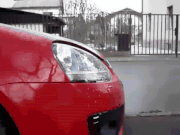
Headlamp washers in action on a Volkswagen GTI
Dirt buildup on headlamp lenses increases glare to other road users, even at levels too low to reduce seeing performance significantly for the driver.[citation needed] Therefore, headlamp lens cleaners are required by ECE Regulation 48 on vehicles equipped with low-beam headlamps using light sources that have a reference luminous flux of 2,000 lumens or more.[19] This includes all HID headlamps and some high-power halogen units. Some cars have lens cleaners fitted even where the regulations do not require them. North America, for example, does not use ECE regulations, and FMVSS 108 does not require lens cleaners on any headlamps, though they are permitted.
Lens cleaning systems come in two main varieties: a small motor-driven wiper blade or brush conceptually similar to those used on the windshield of the car, or a fixed or pop-up high-pressure sprayer which cleans the lenses with a spray of windshield washer fluid. Most cars these days use high-pressure sprayers instead of the wiper system, to reduce aerodynamic drag. Some cars with retractable headlamps, such as the original Mazda Miata have a squeegee at the front of the lamp recess which automatically wipes the lenses as they are raised or lowered, although it does not provide washer fluid.
See also[]
- Automotive lamp types
- Automotive lighting
- Automotive night vision
- Fog
- Headlight flashing
- Hidden headlamps
- ISIRI 6672
- Lighting-up time
- Twilight Sentinel
- World Forum for Harmonization of Vehicle Regulations
References[]
- ↑ "Oxford English Dictionary". Retrieved on 14 November 2013.
- ↑ Varghese, Cherian; Shankar, Umesh (May 2007), "Passenger Vehicle Occupant Fatalities by Day and Night – A Contrast", Traffic Safety Facts, Research Note (DOT HS 810 637) (NHTSA’s National Center for Statistics and Analysis), http://www-nrd.nhtsa.dot.gov/Pubs/810637.PDF. Retrieved on .
- ↑ Georgano, G. N. (2002). Cars: Early and Vintage, 1886-1930 (A World of Wheels Series). Mason Crest. ISBN 978-1-59084-491-5.
- ↑ Walker, Richard (1999). The Eventful Century. Reader's Digest. ISBN 0-276-42259-7.
- ↑ World Car Catalog
- ↑ ECE R112PDF (313 KB)[dead link]
- ↑ ECE R98PDF (843 KB)[dead link]
- ↑ FMVSS No. 108PDF (2.00 MB)
- ↑ Rumar, Kåre (2000). Relative merits of the U.S. and ECE high-beam maximum intensities and of two- and four-headlamp systems. UMTRI.
- ↑ AA {UK Automobile Association}—Driving Abroad: Headlights
- ↑ Canada Motor Vehicle Safety Standard 108
- ↑ Europa.eu Press Release "New cars equipped with daytime running lights as of today"
- ↑ "Ya es ley el uso obligatorio de las luces bajas para circular de día" (08-09-2001). Retrieved on 2010-01-29.
- ↑ 14.0 14.1 "Where Does The Glare Come From?" (NHTSA glare response + white paper on headlamp performance, glare, and regulation)PDF (463 KB)
- ↑ Grueninger, Wes (5 March 2008). "Prometheus, Bound: The Difference Between American and European Car Lighting".
- ↑ 16.0 16.1 16.2 Headlamp industry veteran engineer's chronology & commentary on headlamp performance, glare & regulationPDF (3.02 MB) Cite error: Invalid
<ref>tag; name "Dayton" defined multiple times with different content - ↑ Headlamp aim in the aftermarket
- ↑ 18.0 18.1 "Headlamp aiming specifications & procedures". Danielsternlighting.com (2008-01-28). Retrieved on 2010-12-29.
- ↑ 19.0 19.1 19.2 19.3 ECE R48PDF (649 KB)[dead link]
- ↑ Japanese Industrial Standard JIS D-5500 Automobile Parts--Lighting and Light Signaling Devices p. 5, sec. 4.4.2, table #4
- ↑ "New Zealand Vehicle Inspection Requirement Manual p. 4.1.2". Landtransport.govt.nz. Retrieved on 2012-01-31.
- ↑ Icelandic Transport Authority US.321 Information on permitted headlight equipment on vehicles in Iceland.(46 KB)Information on allowed headlight equipment. Umferðastofa Íslands http://ww2.us.is/ Retrieved 2013-11-25.
- ↑ 23.0 23.1 23.2 "Headlamp Optical Systems Illustrated, Explained & Compared". Webcitation.org. Retrieved on 2012-01-31.
- ↑ Spencer, Charles (February 1984), "Headlamp Developments With Dmc Reflectors Including Homofocal Arrangements" (http://www.sae.org/technical/papers/840041),+Society of Automotive Engineers.
- ↑ Schumacher, Thomas W.; Hector Fratty, Guy Dorleans (February 1987), "Improvements in Low Beam Lighting Achieved by Complex Surface Reflectors", Society of Automotive Engineers, http://www.sae.org/technical/papers/870059. Retrieved on .
- ↑ Blusseau, Eric; Laurent Mottet (February 1997), "Complex Shape Headlamps: Eight Years of Experience", Society of Automotive Engineers, http://www.sae.org/technical/papers/970901. Retrieved on .
- ↑ Donohue, R.J.; Joseph, B.W. (February 1973), "Faceted Reflector Fog Lamp Eliminates Lens Fluting", Society of Automotive Engineers, http://www.sae.org/technical/papers/730279. Retrieved on .
- ↑ Fujita, Takeshige; Takeo Ichihara, Hiroo Oyama (February 1987), "Development of Mr (Multi Reflector) Headlamp (Headlamp With Slant Angle of 60 Degrees, Contributable to Future Vehicle Body Styling)", Society of Automotive Engineers, http://www.sae.org/technical/papers/870064. Retrieved on .
- ↑ H4 vs. 9003/HB2 bulbsPDF (52 KB)
- ↑ Chrysler/Sylvania Super-Lite turnpike beamPDF (8.60 MB)
- ↑ "Driving lights-was Re: headlight laws was re improving lightoutput - rec.autos.driving | Google Groups". Groups.google.com (2003-12-06). Retrieved on 2012-01-31.
- ↑ US headlamp replaceable light source docket entry for H1
- ↑ US headlamp replaceable light source docket entry for H3
- ↑ 34.0 34.1 "Glare from Headlamps and other Front Mounted Lamps Federal Motor Vehicle Safety Standard No. 108; Lamps, Reflective Devices, and Associated Equipment".
- ↑ 35.0 35.1 "Be Careful: Dangerous Products! HID kits and the law". Hella. Retrieved on 2010-12-29.
- ↑ NHTSA ILLEGAL LIGHTING CRACKDOWN CONTINUES
- ↑ 37.0 37.1 ECE Regulation 37 for motor vehicle filament bulbsPDF (1.78 MB)[dead link]
- ↑ ECE Regulation 99 for motor vehicle HID bulbsPDF (268 KB)[dead link]
- ↑ "49CFR564 Replaceable Bulb Headlamp Light Source List". Fmvss108.tripod.com. Retrieved on 2010-12-29.
- ↑ Sivak, M; Michael J. Flannagan, B. Schoettle (2006), "Mercury-free HID headlamps: glare and color rendering" (PDF), University of Michigan Transportation Research Institute, http://deepblue.lib.umich.edu/bitstream/2027.42/55201/1/UMTRI-2004-37.pdf. Retrieved on .
- ↑ Flannagan, Michael J; Juha Luoma, A.W. Gellatly, M. Sivak (1992), "Ranges of stop sign chromaticity under tungsten-halogen and high-intensity discharge illumination", University of Michigan Transportation Research Institute, http://mirlyn-classic.lib.umich.edu/F/?func=direct&doc_number=005511681&local_base=UMTRI_PUB. Retrieved on .
- ↑ Flannagan, Michael J; M. Sivak (1989), "Colors of retroreflective traffic sign materials when illuminated by high-intensity-discharge headlights.", University of Michigan Transportation Research Institute, http://mirlyn-classic.lib.umich.edu/F/?func=direct&doc_number=005505889&local_base=UMTRI_PUB. Retrieved on .
- ↑ Sivak, M; T Sato, D.S. Battle, E.C. Traube, Michael J. Flannagan (1993), "In-traffic evaluations of high-intensity discharge headlamps: overall performance and color appearance of objects", University of Michigan Transportation Research Institute, http://mirlyn-classic.lib.umich.edu/F/?func=direct&doc_number=005512803&local_base=UMTRI_PUB. Retrieved on .
- ↑ "Evaluation of High Intensity Discharge Automotive Forward Lighting" (PDF). Retrieved on 2010-12-29.
- ↑ "VISION Congress report". Drivingvisionnews.com (2008-09-02). Retrieved on 2010-12-29.
- ↑ "Osram Automotive Lamps Lighting Programme 2005-06". Friarsmarketing.com. Archived from the original on 2009-03-20. Retrieved on 2010-12-29.
- ↑ "The Difference Between US and European Lights". Motivemag.com. Retrieved on 2010-12-29.
- ↑ NHTSA headlamp glare docket
- ↑ "What Is Glare? p. 24". Webcitation.org. Retrieved on 2012-01-31.
- ↑ "KOITO and DENSO Develop World's First Mercury-Free High-Intensity Discharge Headlamp System". Prnewswire.com. Retrieved on 2010-12-29.
- ↑ "HID headlamp system has a newly developed mercury-free discharge bulb". Goliath.ecnext.com (2004-07-27). Retrieved on 2010-12-29.
- ↑ VW Golf Mk5 LED headlamp study and prototype as of 2005
- ↑ "New-generation LED headlamp prototype with performance equal to HID". Fourtitude.com. Retrieved on 2010-12-29.
- ↑ "DVN Interview with Hella's Hans-Theo Dorissen, 2 June 2009". Drivingvisionnews.com. Retrieved on 2010-12-29. (registration required)
- ↑ "Production LED headlamp technology & design as of 2007". Al-lighting.de. Retrieved on 2010-12-29.
- ↑ "LED Headlights Introduced". TreeHugger. Retrieved on 2009-11-29.
- ↑ "DVN Interview with AL's Michael Hamm, 8 July 2009". Drivingvisionnews.com. Retrieved on 2010-12-29.
- ↑ [1]
- ↑ "Industry First LED Headlamp for Premium SUV". Retrieved on 2012-01-31.
- ↑ Flannagan, Michael J.; Michael Sivak, Brandon Schoettle (November 2007), "Benefits of Headlamp Leveling and Cleaning for Current U.S. Low Beams" (PDF), UMTRI, http://deepblue.lib.umich.edu/bitstream/2027.42/58733/1/100247.pdf. Retrieved on .
- ↑ "Myth or fact: The Citroën DS Pioneered directional headlights". dsgoddess.com. Retrieved on 2009-11-29.
- ↑ "EUREKA AFS task force". Memagazine.org. Retrieved on 2012-01-31.
- ↑ "First Drive: 2004 Lexus RX 330". Edmunds.com (2003-01-05). Retrieved on 2009-05-02.
- ↑ pechmi2. "AFS on Skoda". Hella.com. Retrieved on 2012-01-31.
- ↑ "AFS on Opel/Vauxhall Insignia". Netcarshow.com. Retrieved on 2012-01-31.
- ↑ "ABCs of AFS". Mvlc.info (2012-01-27). Retrieved on 2012-01-31.[dead link]
- ↑ "Predictive AFS via GPS Nav data". Ieeexplore.ieee.org. Retrieved on 2012-01-31.
- ↑ Mefford, M.L.; Flannagan, M.J.; Bogard, S.E. (2006), Real-world use of high-beam headlamps, University of Michigan Transportation Research Institute, http://hdl.handle.net/2027.42/58716. Retrieved on .
- ↑ "Jacob Rabinow - patent 2917664". Museum.nist.gov. Retrieved on 2012-01-31.
- ↑ Rabinow, Jacob (1990-5). Inventing for Fun and Profit. San Francisco, CA: San Francisco Press. ISBN 978-0-911302-64-6.
- ↑ "Built In Visor Shades Headlamps." Popular Mechanics, August 1956, p. 70.
- ↑ "Daimler: New headlamp and night-view systems". Media.daimler.com (2008-11-12). Retrieved on 2012-01-31.
- ↑ "Adaptive Highbeam Assist - the Intelligent Headlamp". Retrieved on 4 November 2012.
- ↑ "Daimler HighTechReport 1/2009: Safety - Night Sight: Variable headlights for enhanced safety". Retrieved on 18 February 2010.[dead link]
- ↑ "Daimler: New headlamp and night-view systems: Adaptive Highbeam Assist selects the optimum light settings automatically". Retrieved on 18 February 2010.
- ↑ "Dr. Jürgen Seekircher, Bernd Woltermann, Dr. Axel Gern, Reinhard Janssen, Dirk Mehren, Martin Lallinger: "The Car Learns How to See - Camera-Based Assistance Systems" in "The New E-Class by Mercedes-Benz", Springer Automotive Media, Wiesbaden". Retrieved on 18 February 2010.
- ↑ "Fascinating light - dynamics through technology and design". Retrieved on 19 February 2010.
- ↑ "Lighting technology". Retrieved on 17 February 2010.
- ↑ "Mobileye & Visteon". Retrieved on 18 February 2010.
- ↑ "Adaptive Lighting Systems". Driving Vision News (2010-08-31). Retrieved on 2012-01-31.
- ↑ "The New Volkswagen Touareg SUV is One of the Safest Automobiles of All Time". Retrieved on 17 March 2010.
- ↑ "New Touareg takes the SUV idea into the future". Retrieved on 17 February 2010.
- ↑ "Phaeton debuts with new design and new technologies". Retrieved on 22 April 2010.
| ||||||||||||||||||||||||||||||||||||||||||||||||||
| This page uses some content from Wikipedia. The original article was at Headlamp. The list of authors can be seen in the page history. As with Tractor & Construction Plant Wiki, the text of Wikipedia is available under the Creative Commons by Attribution License and/or GNU Free Documentation License. Please check page history for when the original article was copied to Wikia |